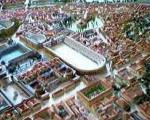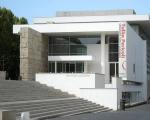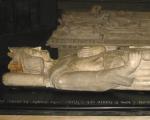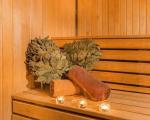Bois de Boulogne. Interesting Facts
(le bois de Boulogne) is a huge park in the west of the city, covering an area of 846 hectares. It is 2.5 times larger than Central Park in New York and 3.3 times larger than Hyde Park in London. The Bois de Boulogne is located in the 16th arrondissement of Paris.
According to films and books, the forest is also known for prostitutes and maniacs who ply their trade in the evening and at night. However, Parisians claim that the Bois de Boulogne is safe and they have never heard of its bad reputation.
How to get there:
Metro: Porte-Dauphine, Porte-d'Auteuil
RER: Porte-Maillot ou Avenue Foch
The Bois de Boulogne contains:
Playground for children
Bicycle rental at the entrance to the zoo and at the Lower Lake pier
Boat rental on Lower Lake
Rollerblading rental
Fishing (you must have a special APNLE permit)
Horse Club
Restaurants
History of the Bois de Boulogne
The Bois de Boulogne arose from the remains of the ancient oak forest of Rouvray (Bois de Rouvray) within the commune of Compiegne, first mentioned back in 717. King Childeric II donated the land to the influential Abbey of Saint-Denis, which founded several monasteries, but Philip II Augustus bought most of the land from the monks for hunting. Gradually, the city came close to the forest and most of the animals left the places flooded with people.
origin of name
In 1308, Philip the Fair, after a pilgrimage to Boulogne-sur-Mer (Boulogne-on-the-Sea), ordered the construction of the Church of Our Lady of Boulogne in the Parisian forest. This is how Boulogne-sur-Seine (Boulogne-sur-Seine) and the Bois de Boulogne got their names.
During the Hundred Years' War, the forest became a haven for thieves. In 1416-1417, the troops of the Duke of Burgundy burned part of the forest. Under Louis XI, the forest was replanted, and two roads now passed through it.
At the beginning of the 18th century, the Bois de Boulogne became a favorite walking place for the Parisian nobility. Louis XVI made this forest a public park, opening it to everyone.
Under Napoleon III in 1852-1858. The forest plan was completely revised: alleys with a total length of 80 km were laid, lakes and rivers were dug, 400,000 trees were planted.
The modern Bois de Boulogne (le bois de Boulogne), covering an area of 8.4 km2, is only a small part of the endless forest of Rouvray that approached Paris from the west in the 1st millennium AD. It got its name from the church of Notre-Dame de Boulogne, built in 1319-1330 by order of King Philip the Fair in the lumberjack village of Menul-les-Saint-Clos on the southern outskirts of the forest.
Royal Dominions
The Bois de Boulogne has been known from historical sources since the beginning of the 8th century. In 717, it is mentioned in the Compiegne Rite as a gift from King Childeric II to the powerful Abbey of Saint-Denis. About 450 years later, Philip Augustus buys most of the forest from the monks in order to hunt in these places.
During the Hundred Years' War, the Bois de Boulogne becomes a very dangerous place, as numerous brigand gangs of Englishmen hide in its thicket. In 1416-1417, especially many people died in it due to frequent attacks by armed detachments of the Duke of Burgundy. During these same years, a significant part of the forest was destroyed by fires.
Under Louis XI, the burned areas of the forest were planted with new trees and new roads were built. In 1528, Francis I ordered the construction of a royal residence on the edge of the forest near Neuilly-sur-Seine, which became known as the Château de Madrid and Château de Boulogne. From that time on, the Bois de Boulogne became a favorite vacation spot for the court nobility. The castle itself was later destroyed during the revolution at the end of the 18th century.
The royal hunting grounds in the forest under Henry III were surrounded by a high hedge with eight gates. His successor, King Henry IV, strives to develop sericulture in France and for this purpose orders 15 thousand mulberry trees to be planted in the forest. In 1777, the magnificent park of the Comte d’Artois with the “toy palace” Bagatelle appeared in the center of the forest. 
Until the end of the 18th century. On the territory of the Bois de Boulogne there was another now lost castle - Chateau de la Mette (Le château de la Muette). In the 16th century it was the main residence of Margaret of Valois after her divorce from Henry of Navarre. In 1783, the first ever flight in a Montgolfier balloon began from the lawn near its walls. A modern building under the same name was built on this site by the architect L. Hesse in 1920-1921 for the Organization for Economic Cooperation and Development.
In the first post-revolutionary years, the Bois de Boulogne became the last refuge for people persecuted by the revolutionary Convention. At the end of the Napoleonic Wars in 1814-1815, a huge military camp was deployed in the forest, which housed 40 thousand soldiers of the Russian and English armies. Their stay caused significant damage to the forest, to compensate for which until 1830, massive plantings of American oak were carried out.
Imperial transformations
In 1853, Emperor Napoleon III acquired the Bois de Boulogne from the Paris City Hall and from that moment a new chapter was written in its history. Architects Zh. Hitrof and engineer Zh-Sh were invited to update the layout of the forest. Alphand and landscape designer J. P. B. Deschamps. The progress of the work, which lasted 4 years, was supervised by the prefect of the Seine department, Baron Haussmann.
As a result, the emperor’s wish to create a forest park modeled on Hyde Park was partially realized. Many winding paths appeared in the Bois de Boulogne, the terrain was transformed, and two large artificial lakes with islands were created on the Var stream, connected by a channel to a cascade of waterfalls. Additionally, 200 thousand trees of various species were planted to renew the forest. 
On an island on the Lower Lake, a Swiss-style chalet was built in which the restaurant Le Chalet Des Iles opened. In 1855-1858, the first Longchamp racecourse was built on a flat area of forest. At the same time, in the area of the future Boulogne-Billancourt on the outskirts of the Bois de Boulogne, the construction of elite mansions was allowed.
During the Siege of Paris in 1870, many trees in the forest were severely damaged by artillery fire from the warring parties, especially in the Mare d'Auteuil forest area, since one of the French batteries was located here. After the war, a second Auteuil racecourse was opened in the forest, built in 1873.
Within the city limits (XX-XXI centuries)
In 1925, the Bois de Boulogne, which until this year had economically belonged to the city hall of Paris, was annexed to the French capital in an administrative-territorial sense. Since that time, all work on its improvement has been under the jurisdiction of the administration of the XVI district of the capital. About 56% of the trees growing here belong to various subspecies of oaks. A significant area of the forest is also occupied by pine groves and acacia thickets. 
There are 86 km of paths for various purposes throughout the forest: for walking, horse riding, jogging and cycling. The forest park is decorated with several dozen fountains. In addition to the largest Upper and Lower lakes, there are other bodies of water in the forest. including the ponds of Suresnes, St. James, Longchamp, Boulogne, Armenouville and several small rivers. After a walk, you can relax and recuperate in one of 18 cafes and restaurants in any corner of the forest.
Since 1925, the French Open Tennis Championship, the Rolland-Garos tournament, has been held in the Bois de Boulogne. The stadium specially built for it was expanded in 1968, 1986 and 1992-1994. There is currently a new project for its reconstruction in the coming years.
In addition to sports facilities, in the forest there is a riding school, branches of the Botanical Garden, Bagatelle Park and the Auteuil Greenhouse, an acclimatization garden for exotic plants, a children's amusement park and a small zoo. 
The Bois de Boulogne is a wonderful place of recreation and entertainment for Parisians and city guests of any age, but it is not advisable to visit it in the evening with children, since at this time of day in its alleys you can often meet people offering various sexual services.
How to get there
Address: Bois de Boulogne, Paris 75016Metro: Porte d'Auteuil
RER train: Avenue Henri Martin, Avenue Foch
Updated: 06/29/2017
Bois de Boulogne(French: Bois de Boulogne) is a park complex, one of the largest green areas of Paris, which is called the “western lung” of the capital (while the Bois de Vincennes is the “eastern lung”). Its area is 846 hectares.
| content: |
The Bois de Boulogne also houses several museums. For example, Museum of Traditions and Folk Art France. It demonstrates to visitors such crafts as pottery and weaving, cattle breeding and stonemasons. The exhibits used here were those that were in use long before industrialization and the advent of power tools. The lower floor of the museum is a research department - here you can get acquainted with folk crafts and read information about them on slides. The museum reflects the history of life and crafts of the French people.
Children will find it interesting to visit Climate Garden, where the menagerie, museum, attractions and playgrounds are located. And, of course, the lakes of the Bois de Boulogne, where you can take a boat trip. On the lower lake it is worth seeing the small island where a charming Moorish gazebo was built for Empress Eugenie in the mid-19th century. Of course, by renting a bicycle you can explore the Bois de Boulogne much faster.
This is what this place looks like during daylight hours - a paradise for tourists, many active recreation areas and greenery, greenery, greenery. At night, the Bois de Boulogne becomes a gathering place for Parisian prostitutes. You can even find transsexuals here. So, in addition to the wonderful alleys, gardens, parks and flowers, the Bois de Boulogne also has such fame, although the government is taking measures to eliminate this. Books and films also attribute to it the bad reputation of a favorite place for maniacs, but the Parisians themselves deny this fact. On weekends, many people gather in the park - the French play sports here and relax with their families on the green lawns. You can visit local restaurants or cafes, among which Chalet des Iles, located on one of the artificial islands, is especially popular. A ferry goes to it.
- group excursion (no more than 15 people) for a first acquaintance with the city and main attractions - 2 hours, 20 euros
- discover the historical past of the bohemian quarter, where famous sculptors and artists worked and suffered - 3 hours, 40 euros
- acquaintance with the historical center of Paris from the birth of the city to the present day - 3 hours, 40 euros
If we compare Paris to a precious necklace, then the Bois de Boulogne will take pride of place in it as a bright gem. This park area is beautiful at any time of the year, and it plays an important role in the “anatomy” of Paris. It is called the “western lung” of the capital, along with the “eastern” -.
To enlarge the diagram of the Bois de Boulogne, click on the image below:
Let's start with geography
The Bois de Boulogne (le bois de Boulogne) is located in the 16th arrondissement of Paris near the suburb of Boulogne-Bellancourt and covers an area of 846 hectares. The size is impressive, considering that it is 2.5 times larger than Central Park in New York and 3.3 times larger than London's Hyde Park. The massif is one of the largest parks in the world, and is called a forest only due to historical traditions.On the east, the Bois de Boulogne is bounded by former fortress walls, and on the west by the Seine. The main entrance to the park is located in the northeast of the massif and faces Avenue Foch and Avenue Grande Armée. The western part borders on the Grands Boulevards, and there is a railway junction nearby - the Saint-Lazare station. Nearby are the luxurious aristocratic quarters of Paris.
Creative people poetically call the Bois de Boulogne “an emerald leaf in the boutonniere of Paris.” Its green spaces provide residents of the metropolis with life-giving oxygen. However, botanists consider the park's vegetation to be somewhat monotonous.
Favorite place of robbers and kings
On the site of the Bois de Boulogne there was once a dense oak forest of Rouvray in the vicinity of Boulogne-sur-Mer. The first mention of it is contained in a document of 717 drawn up by King Childeric II of France. According to legend, in 1308 Philip V the Fair was healed here from a serious illness and built the Church of Our Lady of Boulogne on the site of his miraculous recovery. The temple has not survived, but it gave its name to the forest.During the rebellious and turbulent years of the Hundred Years' War, the Bois de Boulogne was favored by thieves and robbers. All these dark personalities operated there so actively that they had to surround the oak grove with a stone wall with a guarded gate. However, these measures did not help much. The situation improved only after the construction of a hunting castle there by Francis II. The robbers were dealt with, and roads were built through the forest.
In the 17th century, duels were held in the Bois de Boulogne, and from the 18th century it became a place for walks for the aristocracy. It was here that Napoleon III drew attention to it, instructing Baron Haussmann to build a park here. Some of the old trees were replaced with pines and acacias, and numerous roads and walking paths were laid. The massif gradually acquired its familiar appearance and became accessible to everyone, from royalty to ordinary citizens. Only oaks remind of the ancient forest; they still make up 56% of all trees.
There is no need to pay to enter the Bois de Boulogne, but there is a fee for the attractions and museums there.Worth to visit:
- Climate garden with a zoo and children's playgrounds.
- A folk art museum that preserves the traditions of ancient crafts.
- Bagatelle Park with a unique rose garden and a beautiful castle. It was built on a dare in just 90 days.
- Auteuil and Longchamp racecourses with a riding school.
- Shakespeare's garden with plants glorified in his great works.
- Auteuil greenhouse with exotic plants from all over the world. Not far from the greenhouses you can see the oldest beech tree in the park, a 200-year-old beech tree.
- Upper and Lower lakes, where you can go boating and relax in Queen Eugenie's Moorish gazebo.

Nightlife in the Bois de Boulogne
The park, like many attractions, has its own “skeleton in the closet”. It is better to plan walks along it during the daytime. With the onset of darkness, the area becomes a kind of Red Light Street, where “moths” and “moths” of various orientations flock. At the time of Hugo and Zola it was said that “in the Bois de Boulogne, one-night stands are celebrated without the participation of a priest.” And where corrupt love reigns, crimes are not far away, so tourists risk finding not very pleasant adventures on their own. |
| | | |
Park in Paris. A complete dictionary of foreign words that have come into use in the Russian language. Popov M., 1907. FOREST OF BOULONN park on the western side of Paris. Dictionary of foreign words included in the Russian language. Pavlenkov F., 1907 ... Dictionary of foreign words of the Russian language
FOREST OF BOULONS- (Bois de Boulogne), a park on the western outskirts of Paris (see PARIS). Area 848 hectares. The Bois de Boulogne arose from a forest area that belonged in the 8th century. Abbey of Saint Denis, in the 16th - 18th centuries. kings of France. From the 17th century became a place for walking. The first alleys... ... encyclopedic Dictionary
Bois de Boulogne- Lake in the Bois de Boulogne Horse racing in the Bois de Boulogne. Edouard Manet, 1864 The Forest of Boulogne (French bois de Boulogne), covering an area of 846 hectares, is located in the 16th arrondissement in the west of Paris. The so-called “lung” of the French capital (the second “lung” ... Wikipedia
Bois de Boulogne- (Bois de Boulogne) park on the western outskirts of Paris. Area 848 hectares. It arose on the basis of a forest that belonged in the 8th century. Abbey of Saint Denis, in the 16th - 18th centuries. French kings. From the 17th century became a place for walking. The first alleys appeared in 1815... Great Soviet Encyclopedia
Bois de Boulogne- see Paris... Encyclopedic Dictionary F.A. Brockhaus and I.A. Ephron
Bois de Boulogne- Boulevard forest (in Paris) ... Russian spelling dictionary
Bois de Boulogne- (Bois de Boulogne)Bois de Boulogne, park to the west. outskirts of Paris, France, located south of Avenue Charles de Gaulle; pl. 865 hectares. This territory was once part of the royal hunting grounds and enjoyed a reputation as a favorite place... ... Countries of the world. Dictionary
Bois de Vincennes- Coordinates: 48°49′41.05″ N. w. 2°25′58.5″ E. d. / 48.828069° n. w. 2.432917° E. d. ... Wikipedia
FOREST OF BOULONS- The famous four-hundred-meter corridor of the main building of St. Petersburg State University. Probably because people came there to see and show themselves, like Parisians in the Bois de Boulogne... Petersburger's Dictionary
Paris- capital of France. Known already in the 1st century. BC e. like the village of Lutetia, name from Gallic. lut swamp, i.e. a settlement in a swamp. Later Lutetia Parisiorum from the ethnonym Parisia, Gallic. tribe that lived on the banks of the Seine. Then Parisiorum, and... ... Geographical encyclopedia
Books
- Paris. Issue 16, . Guide 171; Posters 187; for Paris - a fascinating and detailed guide to the French capital, which tells about everything important and interesting that has happened on the banks of the Seine since... Buy for 696 rubles
- Walks around Paris. Right Bank, Boris Nosik. Boris Nosik, a writer and translator who lived in the French capital for more than fifteen years, again invites readers who are already familiar with his book “Walks in Paris. Left bank and islands`,…




